Navigate the intriguing biblical history of dreadlocks and discover how ancient vows weave into modern spirituality and identity.

Dreads in the Bible
You might be surprised to learn that the concept of dreadlocks, or at least uncut hair, holds significance in biblical narratives, particularly within the context of the Nazirite vow. This ancient commitment, detailed in the scriptures, involved abstaining from cutting one's hair to signify a special devotion to God, a practice that might remind you of the story of Samson and his unshorn locks.
As we unravel the historical and spiritual layers surrounding hair in biblical times, you'll find intriguing connections between ancient practices and modern interpretations of faith and identity, inviting you to ponder how these ancient texts influence contemporary views on spirituality and self-expression.
Key Takeaways
- Hair, including dreads, symbolizes spiritual devotion and identity in biblical narratives.
- The Nazirite vow emphasizes uncut hair as a sign of consecration to God.
- Samson's strength and covenant with God were deeply connected to his unshorn hair.
- Modern interpretations of dreadlocks reflect ongoing debates about spirituality and cultural identity.
Historical Context of Hair
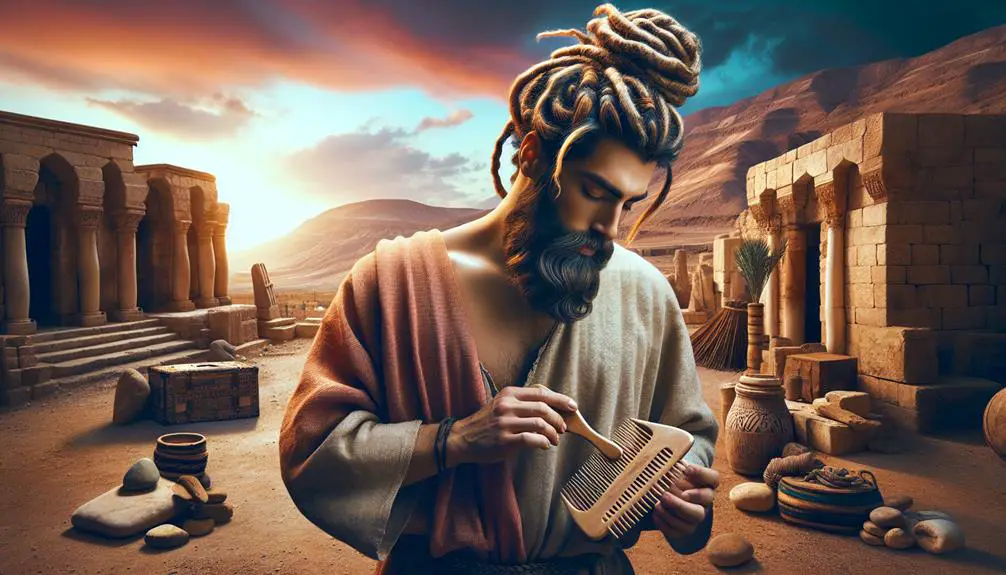
Tracing back through history, it's evident that hairstyles, including dreads, have played a pivotal role in cultural identity and social status across various civilizations. Ancient hairstyles weren't merely about personal grooming; they were imbued with significant cultural, religious, and social meanings. For example, in ancient Egypt, hair dyeing practices were widespread among the elite, signifying status and adherence to cultural norms. They used natural dyes obtained from plants to color their hair, showcasing their innovation and the importance of appearance in their society.
Similarly, in ancient societies across Africa, intricate hairstyles, including early forms of dreadlocks, signified one's tribe, age, marital status, wealth, and even religion. These hairstyles were more than just fashion statements; they were a language of identity. The meticulous care and cultural practices surrounding hair in these civilizations underline the profound significance hair held.
It's crucial to understand the depth of these hair dyeing practices and ancient hairstyles to fully appreciate their historical contexts. They weren't just about aesthetics but were deeply entrenched in the fabric of ancient societies, marking rites of passage, social hierarchy, and spiritual beliefs. This historical lens offers a richer understanding of the cultural significance of hairstyles like dreads beyond mere fashion or trend.
Nazirite Vow Explained
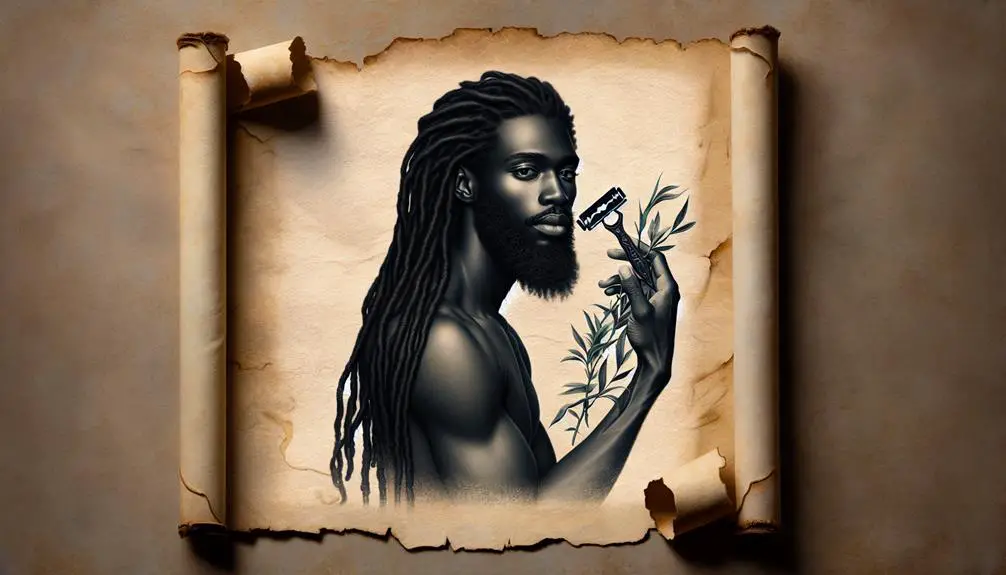
You'll find the Nazirite vow central to understanding the religious and cultural significance of hair, specifically dreadlocks, within ancient biblical contexts.
This vow's origins and purpose, alongside its strict requirements and restrictions, illuminate a profound dedication to spiritual purity and separation.
Origins and Purpose
One must understand the Nazirite vow to grasp the origins and purpose behind the biblical reference to dreads. This vow, deeply rooted in ancient traditions, offers insight into the early forms of what many recognize today as dreadlocks. This hairstyle's evolution and its implications on cultural appropriations highlight a complex journey from religious observance to mainstream fashion.
To fully appreciate this transition, consider the following:
- Spiritual Significance: The Nazirite vow was a form of devotion, with hair playing a central role in one's commitment to God.
- Cultural Context: Understanding the cultural backdrop of the vow illuminates the original purpose of this hairstyle.
- Hairstyle Evolution: Over centuries, what began as a religious symbol transformed across cultures.
- Cultural Appropriations: The modern adaptation of dreadlocks embodies a blend of respect, misunderstanding, and appreciation for its origins.
Requirements and Restrictions
Delving into the Nazirite vow reveals a set of stringent requirements and restrictions that underscore its profound spiritual significance.
You'll find that beyond a simple commitment to abstain from wine and dead bodies, the vow intricately ties to personal hygiene and cultural significance.
Specifically, the prohibition against cutting one's hair during the vow period isn't just about letting dreads form; it's a physical manifestation of one's dedication to a life set apart for divine purposes.
This aspect, often misunderstood, transcends mere appearance, embedding deep cultural and religious meanings into the practice.
It challenges contemporary perceptions of personal hygiene, suggesting that spiritual cleanliness can sometimes supersede physical grooming, thereby offering a nuanced perspective on what it truly means to be 'clean' in both a cultural and spiritual context.
Samson's Unshorn Locks
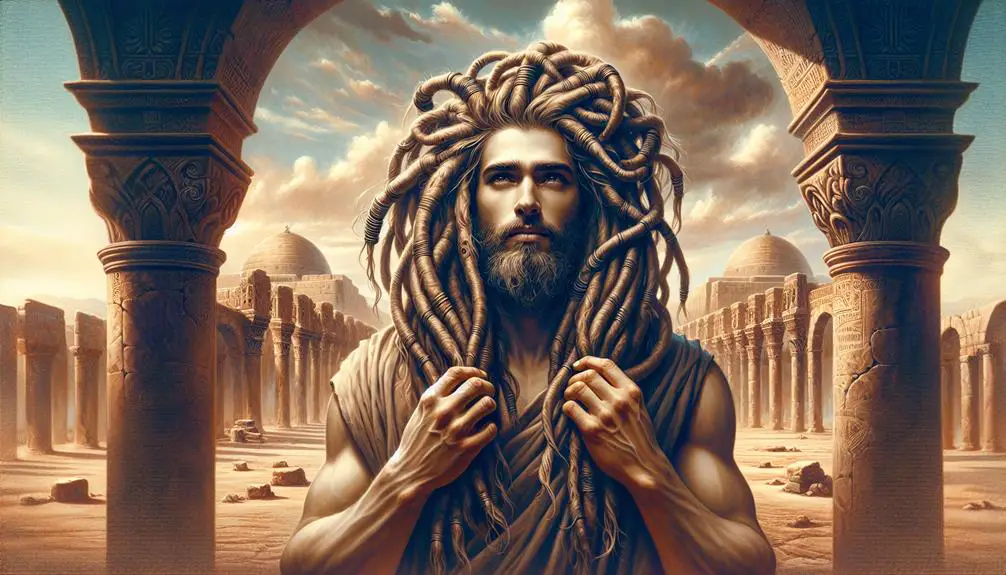
In the narrative of Samson, his unshorn locks aren't merely a symbol of physical strength but also reflect a profound covenant with God. This unique feature of his appearance connects deeply with various aspects of ancient culture and religious practices. Samson's hair wasn't just any hair; it was a testament to his Nazirite vow, an outward sign of an inner commitment to divine service.
Let's delve into several key aspects:
- Haircare Methods: Unlike today's plethora of grooming products, ancient haircare was rudimentary. Samson's locks likely required minimal interference, aligning with the Nazirite vow of not cutting the hair. This simplicity symbolizes purity and dedication.
- Cultural Perceptions: In ancient times, hair often symbolized power and virility. Samson's long hair distinguished him, setting him apart as someone consecrated to God. It was a visible sign of his unique strength and his direct link to the divine.
- Religious Significance: His hair was a physical manifestation of his vow, a daily reminder of his service and commitment to God.
- Personal Identity: For Samson, his hair wasn't merely aesthetic but integral to his identity and mission. It encapsulated his strength, faith, and dedication.
Samson's narrative teaches us about the intertwining of faith, identity, and cultural practices through the lens of his unshorn locks.
Symbolism of Hair in Prophecy
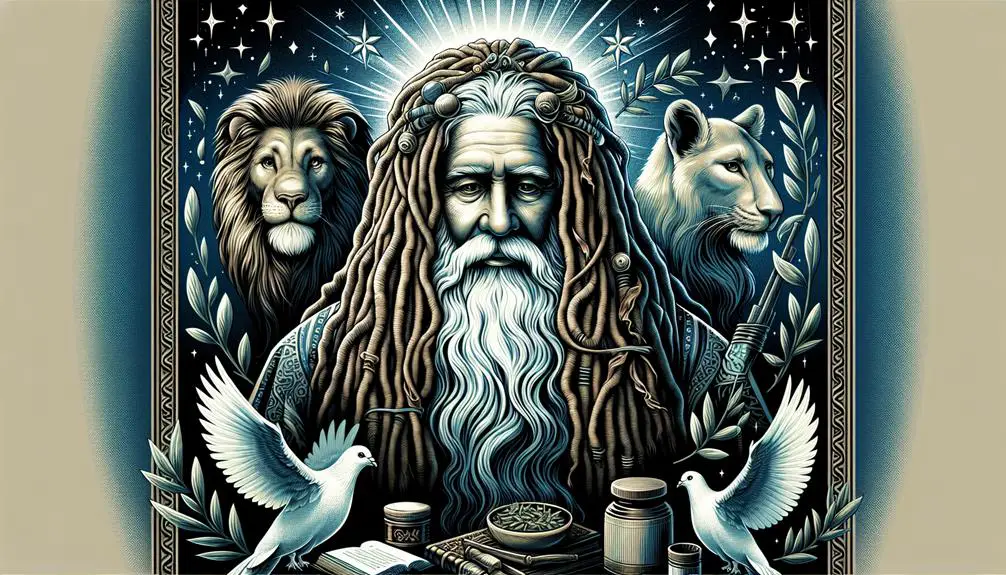
You'll find that hair's role in biblical narratives often transcends mere physical appearance, embodying deeper prophetic significance.
Insights from the Nazirite vow, for instance, illuminate how hair symbolizes a conduit for divine strength and communication, as exemplified by Samson.
Understanding this symbolism offers a richer perspective on the complex interplay between divinity and humanity in biblical prophecy.
Hair's Prophetic Significance
Why does hair hold such profound prophetic significance in biblical narratives, symbolizing covenant, strength, and divine communication? This fascination isn't merely a relic of ancient times but reflects deep-seated cultural perceptions and stylistic expressions that transcend generations.
Consider these factors:
- Cultural Significance: Hair acts as a medium of identity and spiritual status, deeply intertwined with societal norms and values.
- Symbol of Strength: In many stories, hair is depicted as a source of individual power and divine blessing.
- Covenantal Marker: Hair's length and style often signify covenants between the divine and the mortal, marking a person as set apart for God's purposes.
- Prophetic Tool: Prophets used their appearance, including their hair, to communicate divine messages, underscoring the symbiotic relationship between the physical and spiritual realms.
Nazirite Vow Insights
Delving into the Nazirite vow reveals how hair serves not only as a symbolic reservoir of prophetic power but also as a tangible sign of one's consecration to God. This dedication, marked by abstaining from cutting one's hair, underscores a profound personal transformation. It's a visible manifestation of inner purity and a deliberate step away from societal norms.
This vow, therefore, challenges societal perceptions of holiness and commitment, showcasing how external appearances can reflect deep spiritual truths. The uncut hair of a Nazirite becomes a powerful testament to their vow, bridging the gap between the physical and spiritual realms, and inviting observers to reconsider their own commitments to faith and personal growth.
Samson's Strength Source
In the biblical narrative, Samson's hair isn't merely a feature of his physical appearance but serves as a profound symbol of his divine strength and prophetic calling. This symbolism is deeply intertwined with the Nazirite vow, which encompasses:
- Abstaining from alcohol: Symbolizing purity and separation from worldly pleasures.
- Avoiding contact with the dead: Representing spiritual cleanliness and a life dedicated to service.
- Observing dietary restrictions: Denoting obedience to divine commandments, including avoiding certain foods.
- Not cutting one's hair: Hair becomes a tangible representation of one's commitment to God, with Samson's strength directly linked to this vow.
Samson's uncut hair and adherence to these vows enabled him to confront his Philistine enemies, showcasing his role as God's chosen instrument.
Ritual Purity and Hair

Regarding ritual purity and hair, the Bible presents nuanced perspectives that reflect broader theological and cultural principles. You'll find that hair hygiene and its cultural significance were deeply intertwined with notions of cleanliness, identity, and spiritual status.
Aspect |
Cultural Significance |
Biblical Reference |
|---|---|---|
Length of Hair |
Symbol of strength and devotion |
Nazirite Vow |
Shaving Practices |
Associated with purification |
Leviticus 14:8-9 |
Uncut Hair |
Sign of consecration to God |
Numbers 6:5 |
Hair Coverings |
Modesty and respect in worship |
1 Corinthians 11 |
Hair as Identity |
Signifier of tribe and status |
2 Samuel 14:25-26 |
This table reveals a fascinating intersection between physical appearance and spiritual purity. For instance, the Nazirite vow emphasized uncut hair as a mark of one's dedication to God, highlighting the hair's role beyond mere hygiene to encompass a profound cultural and religious significance. Similarly, the practice of shaving for purification rites underlines the transformative power attributed to hair and its management. In these contexts, hair wasn't just a part of one's body but a canvas on which broader cultural and spiritual narratives were drawn.
Modern Interpretations and Debates
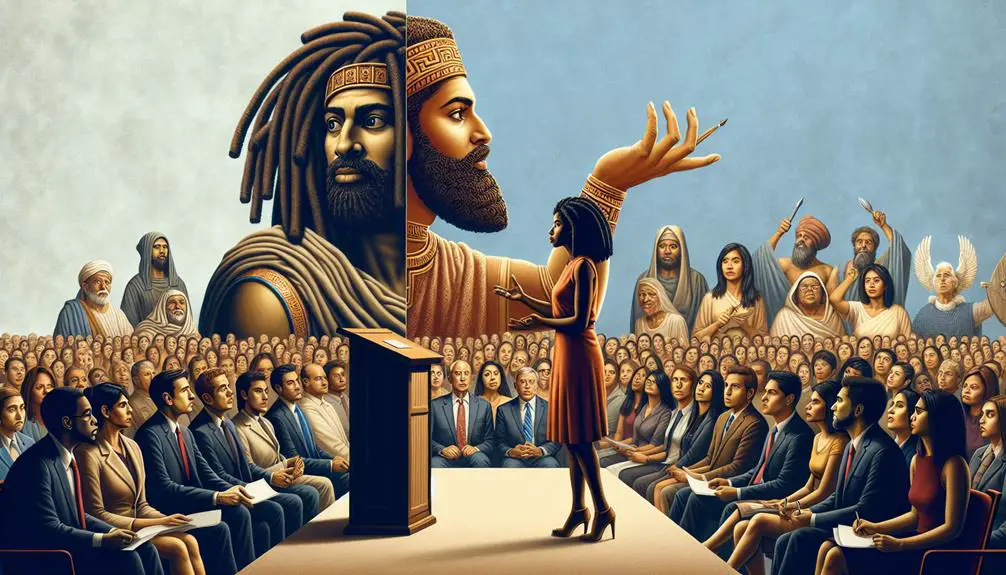
As we explore the ancient perspectives on hair in biblical contexts, it's crucial to examine how these views have evolved into modern interpretations and sparked debates among scholars and believers alike. The discussion around dreadlocks, in particular, has been rich and multifaceted, touching on issues of cultural identity, spiritual significance, and social dynamics.
Here are four key areas of debate:
- Cultural Appropriation: Some argue that the adoption of dreadlocks by individuals outside their cultural or religious origins amounts to cultural appropriation, diluting their historical and spiritual significance.
- Hairstyle Discrimination: There's an ongoing debate about whether discrimination based on hairstyle, particularly dreadlocks, constitutes a form of racial or religious prejudice, especially in professional and academic settings.
- Biblical Interpretation: Scholars and believers debate the biblical references to hair, questioning whether they endorse or merely describe the wearing of dreadlocks.
- Modern Spirituality: The significance of dreadlocks in contemporary spiritual practices is another area of discussion, with some viewing them as a form of devotion or personal expression closely tied to biblical teachings.
These debates reflect the complexity of interpreting ancient texts in a modern context, where cultural sensitivities and historical understanding continually shape our beliefs and practices.
Frequently Asked Questions
How Have Different Translations of the Bible Impacted the Understanding of Dreads or Similar Hairstyles?
Different translations of the Bible have significantly impacted your understanding of dreads and similar hairstyles due to translation discrepancies and cultural interpretations. These variations can alter perceptions, highlighting how deeply our comprehension is intertwined with the language used.
You've likely noticed that what's considered a mere hairstyle in one culture might carry profound spiritual or social significance in another, demonstrating the importance of approaching biblical texts with a nuanced, respectful awareness of these differences.
Are There Any Specific Health Practices Related to Hair Mentioned in Biblical Texts That Could Apply to Maintaining Dreads?
In ancient texts, you'll find no direct shout-out to dreads, but hair washing and scalp care are universally recognized. These practices are crucial for healthy hair, regardless of style.
Biblical references to cleanliness could be interpreted to support meticulous dread maintenance. Specifically, Leviticus mentions grooming rituals that, while not explicitly about dreads, underline the importance of cleanliness, which is fundamental in preventing issues like buildup or infections in any hairstyle.
How Did Early Christian Communities View the Practice of Wearing Dreads or Similar Hairstyles, and Is There Any Evidence of Their Attitudes in Non-Canonical Texts?
You're diving into how early Christian communities perceived hairstyles like dreads. Interestingly, such styles aren't directly mentioned, but through the lens of Nazarite vows and Paul's letters, we gain insights.
Nazarite vows, for instance, involved uncut hair, hinting at a spiritual significance that could parallel dreadlocks.
Paul's letters, on the other hand, don't explicitly cover hair practices but emphasize modesty and propriety, suggesting a nuanced view on appearance.
In What Ways Have Contemporary Rastafarian Beliefs and Practices Regarding Dreads Been Influenced by or Diverged From Biblical Descriptions and Injunctions About Hair?
You're diving into a fascinating exploration, where Rastafarian symbolism and Biblical interpretations entwine and unravel. It's a journey through how contemporary Rastafarian beliefs have either embraced or veered away from the ancient scriptures regarding hair.
How Do Archaeological Findings and Ancient Art Contribute to Our Understanding of the Prevalence and Significance of Dreadlocks or Similar Hairstyles in Biblical Times and Cultures?
When you explore archaeological findings and ancient art, you uncover how dreadlocks or similar hairstyles were prevalent and significant in ancient cultures. These discoveries allow you to delve into the hair symbolism and cultural interpretations of those times.
You'll find that hair often held deep societal and spiritual meanings, shaping how communities viewed identity and divinity. This analysis enriches your understanding of historical practices and beliefs surrounding hair, beyond mere fashion or trend.
Conclusion
In your journey through the tangled narratives of history, you've discovered that hair, specifically dreads, isn't just a strand of keratin but a woven tapestry of faith, strength, and identity.
The Nazirite vow and Samson's saga remind us that each lock can be a symbol of divine commitment, while prophetic visions and purity laws showcase hair's deeper spiritual resonance.
As you ponder modern interpretations, remember, the debates surrounding these ancient practices illuminate our ongoing quest for understanding and connection in a diverse world.



Sign up